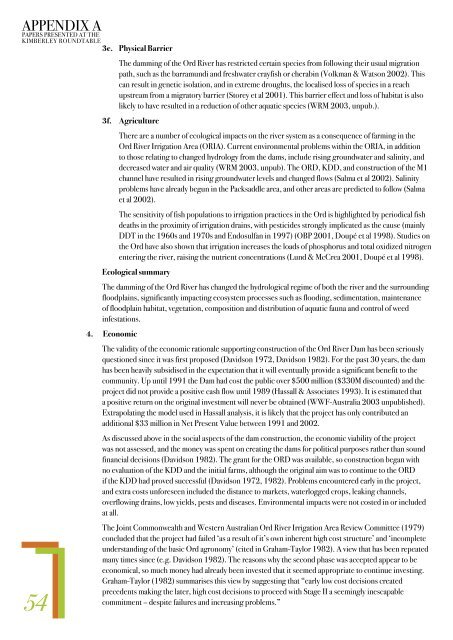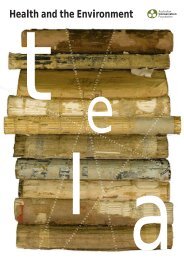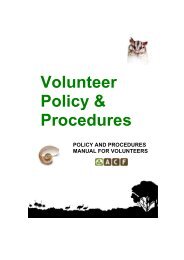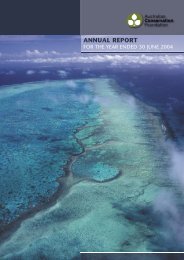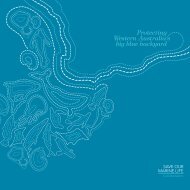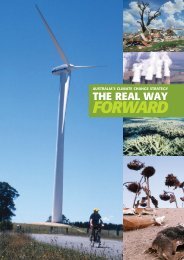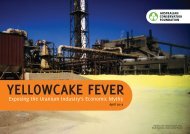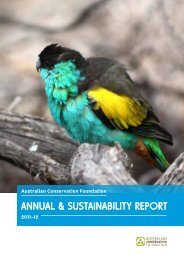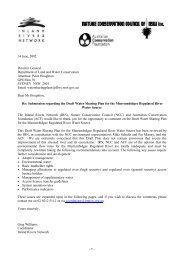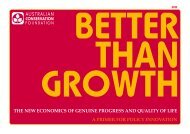Kimberley Appropriate Economics Interim Report - Australian ...
Kimberley Appropriate Economics Interim Report - Australian ...
Kimberley Appropriate Economics Interim Report - Australian ...
Create successful ePaper yourself
Turn your PDF publications into a flip-book with our unique Google optimized e-Paper software.
54<br />
3e. Physical Barrier<br />
The damming of the Ord River has restricted certain species from following their usual migration<br />
path, such as the barramundi and freshwater crayfish or cherabin (Volkman & Watson 2002). This<br />
can result in genetic isolation, and in extreme droughts, the localised loss of species in a reach<br />
upstream from a migratory barrier (Storey et al 2001). This barrier effect and loss of habitat is also<br />
likely to have resulted in a reduction of other aquatic species (WRM 2003, unpub.).<br />
3f. Agriculture<br />
There are a number of ecological impacts on the river system as a consequence of farming in the<br />
Ord River Irrigation Area (ORIA). Current environmental problems within the ORIA, in addition<br />
to those relating to changed hydrology from the dams, include rising groundwater and salinity, and<br />
decreased water and air quality (WRM 2003, unpub). The ORD, KDD, and construction of the M1<br />
channel have resulted in rising groundwater levels and changed flows (Salma et al 2002). Salinity<br />
problems have already begun in the Packsaddle area, and other areas are predicted to follow (Salma<br />
et al 2002).<br />
The sensitivity of fish populations to irrigation practices in the Ord is highlighted by periodical fish<br />
deaths in the proximity of irrigation drains, with pesticides strongly implicated as the cause (mainly<br />
DDT in the 1960s and 1970s and Endosulfan in 1997) (OBP 2001, Doupé et al 1998). Studies on<br />
the Ord have also shown that irrigation increases the loads of phosphorus and total oxidized nitrogen<br />
entering the river, raising the nutrient concentrations (Lund & McCrea 2001, Doupé et al 1998).<br />
Ecological summary<br />
The damming of the Ord River has changed the hydrological regime of both the river and the surrounding<br />
floodplains, significantly impacting ecosystem processes such as flooding, sedimentation, maintenance<br />
of floodplain habitat, vegetation, composition and distribution of aquatic fauna and control of weed<br />
infestations.<br />
4. Economic<br />
The validity of the economic rationale supporting construction of the Ord River Dam has been seriously<br />
questioned since it was first proposed (Davidson 1972, Davidson 1982). For the past 30 years, the dam<br />
has been heavily subsidised in the expectation that it will eventually provide a significant benefit to the<br />
community. Up until 1991 the Dam had cost the public over $500 million ($330M discounted) and the<br />
project did not provide a positive cash flow until 1989 (Hassall & Associates 1993). It is estimated that<br />
a positive return on the original investment will never be obtained (WWF-Australia 2003 unpublished).<br />
Extrapolating the model used in Hassall analysis, it is likely that the project has only contributed an<br />
additional $33 million in Net Present Value between 1991 and 2002.<br />
As discussed above in the social aspects of the dam construction, the economic viability of the project<br />
was not assessed, and the money was spent on creating the dams for political purposes rather than sound<br />
financial decisions (Davidson 1982). The grant for the ORD was available, so construction began with<br />
no evaluation of the KDD and the initial farms, although the original aim was to continue to the ORD<br />
if the KDD had proved successful (Davidson 1972, 1982). Problems encountered early in the project,<br />
and extra costs unforeseen included the distance to markets, waterlogged crops, leaking channels,<br />
overflowing drains, low yields, pests and diseases. Environmental impacts were not costed in or included<br />
at all.<br />
The Joint Commonwealth and Western <strong>Australian</strong> Ord River Irrigation Area Review Committee (1979)<br />
concluded that the project had failed ‘as a result of it’s own inherent high cost structure’ and ‘incomplete<br />
understanding of the basic Ord agronomy’ (cited in Graham-Taylor 1982). A view that has been repeated<br />
many times since (e.g. Davidson 1982). The reasons why the second phase was accepted appear to be<br />
economical, so much money had already been invested that it seemed appropriate to continue investing.<br />
Graham-Taylor (1982) summarises this view by suggesting that “early low cost decisions created<br />
precedents making the later, high cost decisions to proceed with Stage II a seemingly inescapable<br />
commitment – despite failures and increasing problems.”


